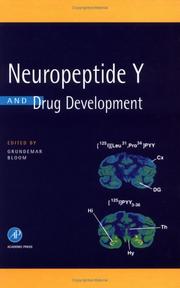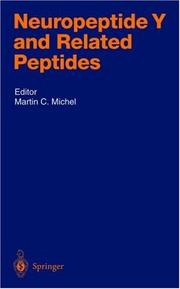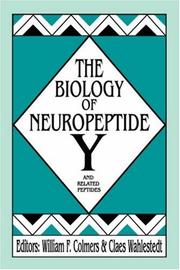| Listing 1 - 10 of 21 | << page >> |
Sort by
|

ISBN: 9780123049902 0123049903 9780080537450 0080537456 1281118931 9781281118936 9786611118938 Year: 1997 Publisher: San Diego : Academic Press,
Abstract | Keywords | Export | Availability | Bookmark
 Loading...
Loading...Choose an application
- Reference Manager
- EndNote
- RefWorks (Direct export to RefWorks)
Neuropeptide Y (NPY) is a ubiquitous and important messenger in the nervous system, with a wide range of physiological roles. It is involved in the body energy balance and is one of the most potent stimuli of food intake known. NPY also acts to regulate central and peripheral autonomic functions.This book, written by academic and industrial experts in the field, links the most recent basic experimental knowledge about NPY and its receptors with areas of clinical importance.This book will be of interest to those working in all areas of research affected by NPY, such as food intak

ISBN: 354040581X Year: 2004 Publisher: Berlin : Springer,
Abstract | Keywords | Export | Availability | Bookmark
 Loading...
Loading...Choose an application
- Reference Manager
- EndNote
- RefWorks (Direct export to RefWorks)
Neuropeptide Y --- Neuropeptide Y --- Derivatives --- Physiological effect. --- Physiological effect.
Article
Abstract | Keywords | Export | Availability | Bookmark
 Loading...
Loading...Choose an application
- Reference Manager
- EndNote
- RefWorks (Direct export to RefWorks)
Neuropeptide y. --- Rat. --- Stress. --- Ulcus.

ISBN: 0897666542 Year: 1990 Publisher: New York NYAS
Abstract | Keywords | Export | Availability | Bookmark
 Loading...
Loading...Choose an application
- Reference Manager
- EndNote
- RefWorks (Direct export to RefWorks)
Neuropeptide Y --- Central Nervous System --- Peripheral Nerves --- CENTRAL NERVOUS SYSTEM, physiology --- NEUROPEPTIDE Y, metabolism --- PERIPHERAL NERVES, physiology --- Congresses. --- physiology --- congresses. --- metabolism --- Physiology --- Metabolism --- Central nervous system, physiology --- Central nervous system --- Neuropeptide y, metabolism --- Neuropeptide y --- Peripheral nerves, physiology --- Peripheral nerves

ISBN: 9780123049902 0123049903 9780080537450 0080537456 1281118931 9781281118936 9786611118938 Year: 1997 Publisher: San Diego Academic Press
Abstract | Keywords | Export | Availability | Bookmark
 Loading...
Loading...Choose an application
- Reference Manager
- EndNote
- RefWorks (Direct export to RefWorks)
Neuropeptide Y (NPY) is a ubiquitous and important messenger in the nervous system, with a wide range of physiological roles. It is involved in the body energy balance and is one of the most potent stimuli of food intake known. NPY also acts to regulate central and peripheral autonomic functions.This book, written by academic and industrial experts in the field, links the most recent basic experimental knowledge about NPY and its receptors with areas of clinical importance.This book will be of interest to those working in all areas of research affected by NPY, such as food intak
Neuropeptide Y. --- Neuropeptides. --- Brain peptides --- Nerve tissue proteins --- Neurotransmitters --- Peptides --- Neuropeptide tyrosine --- NPY (Neuropeptide) --- Neuropeptides
Article
Abstract | Keywords | Export | Availability | Bookmark
 Loading...
Loading...Choose an application
- Reference Manager
- EndNote
- RefWorks (Direct export to RefWorks)
Brain. --- Function. --- Nervous system. --- Nervous-system. --- Neuropeptide y. --- Rat. --- Stress. --- System.

ISBN: 0896032418 1475767250 9786610836222 1280836229 1592594654 Year: 1993 Volume: vol *1 Publisher: London Humana Press
Abstract | Keywords | Export | Availability | Bookmark
 Loading...
Loading...Choose an application
- Reference Manager
- EndNote
- RefWorks (Direct export to RefWorks)
Animal psychology and neurophysiology --- Animal biochemistry --- Brain peptides --- NPY (Neuropeptide) --- Neuropeptide Y --- Neuropeptide tyrosine --- Neuropeptiden --- Neuropeptides --- Peptiden [Neuro] --- Peptides [Neuro]

ISBN: 0897666534 Year: 1990 Publisher: New York, N.Y. New York Academy of Sciences
Abstract | Keywords | Export | Availability | Bookmark
 Loading...
Loading...Choose an application
- Reference Manager
- EndNote
- RefWorks (Direct export to RefWorks)
Physiology of nerves and sense organs --- NEUROPEPTIDE Y --- BRAIN --- GENE EXPRESSION --- HYPOTHALAMUS --- PERIPHERAL NERVES --- NOREPINEPHRINE --- PITUITARY-ADRENAL SYSTEM --- CONGRESSES
Book
Year: 2016 Publisher: Frontiers Media SA
Abstract | Keywords | Export | Availability | Bookmark
 Loading...
Loading...Choose an application
- Reference Manager
- EndNote
- RefWorks (Direct export to RefWorks)
Somatic stem cells reside in definite compartments, known as “niches”, within developed organs and tissues, being able to renew themselves, differentiate and ensure tissue maintenance and repair. In contrast with the original dogmatic distinction between renewing and non-renewing tissues, somatic stem cells have been found in almost every human organ, including brain and heart. Mesenchymal stem cells (MSCs) are multipotent cells residing in the connective stroma of adult tissues and organs, endowed with outstanding plasticity and trophic features. Strictly-defined MSCs have been originally described as fibroblastoid cells in the bone marrow stroma, able to give rise to differentiated bone cells. Thereafter, additional tissue sources, including adipose tissue, skin, muscle, among others, have been exploited for isolating cell populations that share MSC-like biological features. MSCs are able to differentiate along multiple mesodermal lineages and are believed to represent the key somatic stem cell within the skeletogenic niche, being conceptually able to produce any tissue included within a mature skeletal segment (bone, cartilage, blood vessels, adipose tissue, and supporting connective stroma). Despite this high plasticity, the claim that MSCs could be capable of transdifferentiation along non-mesodermal lineages, including neurons, has been strongly argued. No clear scientific clue has indeed proved the possibility to achieve a functional non-mesordermal phenotype upon MSCs in vitro induction or in vivo inoculation. Adult osteogenic and neurogenic niches display wide differences: embryo origin, microenvironment, progenitors’ lifespan, lineages of supporting cells. Although similar pathways may be involved, it is hard to believe that the osteogenic and neurogenic lineages can share functional features. Beyond embryo stage, neurogenesis persists throughout postnatal life in the subventricular zone (SVZ) of the forebrain lateral ventricles and in the subgranular zone of the hippocampus of adult brain. Here the principal reservoirs of adult neural stem cells reside in specific niches and generate neurons and glial cells to sustain the turnover of selected brain compartments. Studying these reservoirs is useful to gather information on the specialized cellular microenvironments and molecular signals that are needed to maintain neural stem cells in vivo, regulating the fine equilibrium between proliferation and differentiation, acting on the switch between symmetrical and asymmetrical cell division. Based on this contemporary background, this Research Topic wish to provide an in-depth revision of the state of the art on relevant scientific milestones addressing the differences and possible interconnections and overlaps, between the osteogenic and the neurogenic niche, clarifying the questioned issue of neuronal transdifferentiation of somatic stem cells.
Neuroscience. --- Neuropeptide Y --- Stem Cell Niche --- Mesenchymal Stromal Cells --- Neural Stem Cells --- Regenerative Medicine --- Wnt/beta-catenin signaling --- Bone Marrow --- Neural Crest --- RUNX2
Book
Year: 2016 Publisher: Frontiers Media SA
Abstract | Keywords | Export | Availability | Bookmark
 Loading...
Loading...Choose an application
- Reference Manager
- EndNote
- RefWorks (Direct export to RefWorks)
Somatic stem cells reside in definite compartments, known as “niches”, within developed organs and tissues, being able to renew themselves, differentiate and ensure tissue maintenance and repair. In contrast with the original dogmatic distinction between renewing and non-renewing tissues, somatic stem cells have been found in almost every human organ, including brain and heart. Mesenchymal stem cells (MSCs) are multipotent cells residing in the connective stroma of adult tissues and organs, endowed with outstanding plasticity and trophic features. Strictly-defined MSCs have been originally described as fibroblastoid cells in the bone marrow stroma, able to give rise to differentiated bone cells. Thereafter, additional tissue sources, including adipose tissue, skin, muscle, among others, have been exploited for isolating cell populations that share MSC-like biological features. MSCs are able to differentiate along multiple mesodermal lineages and are believed to represent the key somatic stem cell within the skeletogenic niche, being conceptually able to produce any tissue included within a mature skeletal segment (bone, cartilage, blood vessels, adipose tissue, and supporting connective stroma). Despite this high plasticity, the claim that MSCs could be capable of transdifferentiation along non-mesodermal lineages, including neurons, has been strongly argued. No clear scientific clue has indeed proved the possibility to achieve a functional non-mesordermal phenotype upon MSCs in vitro induction or in vivo inoculation. Adult osteogenic and neurogenic niches display wide differences: embryo origin, microenvironment, progenitors’ lifespan, lineages of supporting cells. Although similar pathways may be involved, it is hard to believe that the osteogenic and neurogenic lineages can share functional features. Beyond embryo stage, neurogenesis persists throughout postnatal life in the subventricular zone (SVZ) of the forebrain lateral ventricles and in the subgranular zone of the hippocampus of adult brain. Here the principal reservoirs of adult neural stem cells reside in specific niches and generate neurons and glial cells to sustain the turnover of selected brain compartments. Studying these reservoirs is useful to gather information on the specialized cellular microenvironments and molecular signals that are needed to maintain neural stem cells in vivo, regulating the fine equilibrium between proliferation and differentiation, acting on the switch between symmetrical and asymmetrical cell division. Based on this contemporary background, this Research Topic wish to provide an in-depth revision of the state of the art on relevant scientific milestones addressing the differences and possible interconnections and overlaps, between the osteogenic and the neurogenic niche, clarifying the questioned issue of neuronal transdifferentiation of somatic stem cells.
Neuroscience. --- Neuropeptide Y --- Stem Cell Niche --- Mesenchymal Stromal Cells --- Neural Stem Cells --- Regenerative Medicine --- Wnt/beta-catenin signaling --- Bone Marrow --- Neural Crest --- RUNX2
| Listing 1 - 10 of 21 | << page >> |
Sort by
|

 Search
Search Feedback
Feedback About UniCat
About UniCat  Help
Help News
News